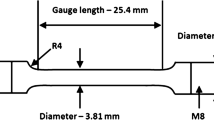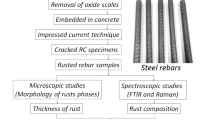Abstract
The influence of the strength, the tempering temperature, and the time between the end of rolling and the beginning of tempering on the stress corrosion cracking resistance of strength class A1000 reinforcing bars made of 22Kh2G2AYu steel in a boiling nickel solution (60% Ca (NO3)2 + 5% NH4NO3 + 35% H2O) at 110°C is studied. Reinforcing bar samples are found to have a relatively low long-term strength. After tempering at 150–450°C for 2 h, the mechanical properties of the steel remain within the strength class A1000 range and the long-term strength increases weakly. Tempering at 500–600°C for 2 h leads to an increase in the long-term strength, but the steel undergoes softening. Storage of the rolled reinforcing bars before tempering for 2–48 h weakly affects the long-term strength.






Similar content being viewed by others
REFERENCES
V. F. Stepanova, Durability of Concrete (Assotsiatsiya Stroitel’nykh Vuzov, Moscow, 2014).
B. A. Kustov, N. V. Pushnitsa, E. D. Demchenko, A. G. Klepikov, and I. L. Fedorova, “On the nature of the fracture of high-strength thermally hardened reinforcing steel,” Stal’, No. 6, 69–74 (1994).
V. T. Chernenko, O. G. Sidorenko, I. P. Fedorova, V. A. Mironov, and E. M. Demchenko, “Hydrogen embrittlement of high-strength low-carbon silicon-manganese reinforcing steel,” Stal’, No. 6, 85–89 (1988).
A. B. Sychkov, M. A. Zhigarev, and A. V. Perchatkin, “High-strength reinforcing bars made of high-carbon steel,” Vestn. Magnitogorsk Gos. Tekh. Univ., No. 3 (9), 42–45 (2005).
S. V. Snimshchikov, I. N. Surikov, A. V. Kharitonov, and V. A. Kharitonov, “Comparative analysis of modern requirements for reinforcing bars for unstressed reinforced concrete,” Obrab. Sploshnykh Sloist. Mater., No. 2 (41), 56–59 (2014).
V. V. Steblov and L. I. Elshina, “How to improve the corrosion resistance of building reinforcement,” Lit’e Metallurg., No. 1 (82), 85–90 (2016).
S. P. Lynch, “Hydrogen embrittlement (HE) phenomena and mechanisms,” in Stress Corrosion Cracking (Woodhead Publishing Ltd., 2011), Chapter 2, pp. 90–130.
F. F. Azhogin, Corrosion Cracking and Protection of High-Strength Steels (Metallurgiya, Moscow, 1974).
N. N. Sergeev and A. N. Sergeev, Hydrogen Embrittlement and Cracking of High-Strength Reinforcing Steel: Monograph (Izd. TulGu, Tula, 2017).
GOST 25156–82. Metals. Dynamic Method for Determining Elasticity Characteristics (Izd. Standartov, Moscow, 1982).
M. A. Krishtal and S. A. Golovin, Internal Friction and Structure of Metals (Metallurgiya, Moscow, 1976).
N. N. Sergeev, V. V. Izvolskii, A. N. Sergeev, S. N. Kutepov, A. E. Gvozdev, E. V. Ageev, and D. S. Klement’ev, “Influence of microstructural factors and heat treatment on the corrosion resistance of reinforcing steel of class A600,” Izv. Yugo-Zapadn. Univ. 22 (2(77), 52–63 (2018).
N. N. Sergeev, V. V. Izvolskii, A. N. Sergeev, S. N. Kutepov, A. E. Gvozdev, A. N. Chukanov, and O. V. Pantyukhin, “Effect of the chemical composition of 23Kh2G2T steel on the corrosion cracking resistance,” Izv. Tula Gos. Univ., Tekh. Nauki, No. 9, 409–420 (2018).
G. V. Karpenko and I. I. Vasilenko, Corrosion Cracking of Steels (Tekhnika, Kiev, 1971).
Yu. A. Sterenbogen, D. V. Vasil’iev, E. L. Demchenko, and D. P. Novikova, “Role of peak stresses in the formation of cold cracks in the welded joints of hardenable steels,” Avtomat. Svarka, No. 4, 11–20 (2006).
A. E. Gvozdev, A. G. Kolmakov, O. V. Kuzovleva, N. N. Sergeev, and I. V. Tikhonova, “Mechanical properties of structural and tool steels in the state of pretransformation during thermomechanical action,” Deform. Razrushenie Mater., No. 11, 39–42 (2013).
Funding
This work was supported by the Ministry of Education and Science of the Russian Federation (project no. 11.6682.2017/8.9) and state assignment no. 075-00746-19-00.
Author information
Authors and Affiliations
Corresponding author
Additional information
Translated by K. Shakhlevich
Rights and permissions
About this article
Cite this article
Sergeev, N.N., Kutepov, S.N., Sergeev, A.N. et al. Long-Term Strength of 22Kh2G2AYu Reinforcing-Bar Steel during Corrosion Cracking Tests in a Boiling Nitrate Solution. Russ. Metall. 2020, 434–440 (2020). https://doi.org/10.1134/S0036029520040266
Received:
Revised:
Accepted:
Published:
Issue Date:
DOI: https://doi.org/10.1134/S0036029520040266




